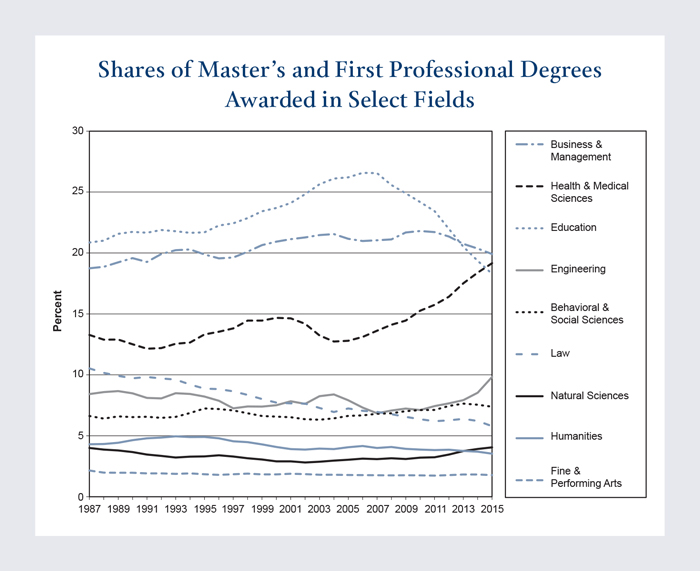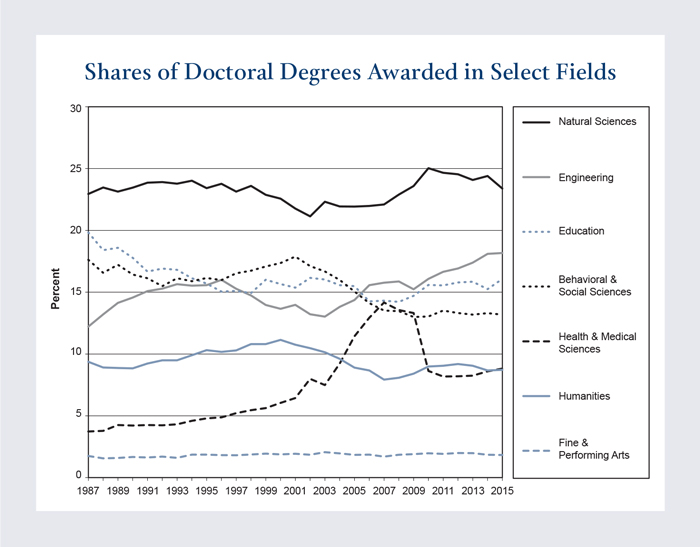Since the Great Recession, news coverage about the state of the humanities has often looked to the trend in undergraduate majors as a sign of the field’s flagging health. But where are those students going, and why? New data from the American Academy’s Humanities Indicators (HumanitiesIndicators.org) reveal a recent substantial shift toward bachelor’s and graduate degrees in the science, technology, engineering, and medical (STEM) fields; the data also highlight some of the underlying complexities in this shift.
From 2006 to 2015, bachelor’s degrees in the STEM fields rose from 22 percent of the baccalaureate degrees awarded to 30 percent of the total – the highest level since detailed national record-keeping began in 1987 (see Figure 1). Much of the recent growth in the STEM fields can be attributed to a sharp increase in the shares of bachelor’s degrees awarded to students in the health and medical sciences, which doubled from 2006 to 2015.
 |
| Figure 1 Source and details at http://humanitiesindicators.org |
During that same time period, all other fields of study experienced a decrease – and in some cases a sharp decrease – in their share of the market. The humanities tend to garner the most attention in the media, and the trend there is substantially downward – the shares of bachelor’s degrees in the humanities fell 20 percent from 2006 to 2015. In explaining the decline, commentators often suggest that students are turning to professional subjects that appear to have clear career paths. The data indicate these assertions may be too simplistic, as two of the largest professional degree subjects are also experiencing substantial declines. Education had the largest proportional decline in share – down 27 percent in the most recent decade with data – while business and management degrees also fell (by 13 percent). What all three subject areas (business, education, and the humanities) have in common is that their share of bachelor’s degrees declined to near historic lows in 2015 while STEM fields approached or reached historically high levels.
A substantial portion of the shifting pattern in degree recipients may be attributed to an increase in the share of women receiving degrees in the health and medical fields. In 2006, 9 percent of women earned baccalaureate degrees in these fields. As of 2015, that share had risen to 16 percent. At the same time, the shares of women earning degrees in business, education, and the humanities all fell to historically low levels.
Liberal Arts Ascendant at Community Colleges
While STEM degrees surged at the bachelor’s level, the share of humanities and liberal arts degrees earned by associate’s degree recipients increased substantially, reaching an unprecedented level in 2015 and accounting for almost 42 percent of the total.
The growth in liberal arts degrees reflects the increased importance of community colleges as a first step toward a four-year college degree, often providing a less expensive way to satisfy general education requirements. (According to the National Student Clearinghouse, 16 percent of students who started their studies at a two-year institution went on to complete a four-year college degree.) Unfortunately, the trend data do not reveal whether, and if so how, the rise of the liberal arts degrees at the associate’s level may be connected to the decline in humanities degrees at the baccalaureate level. The pathways from community college study to the bachelor’s degree remain murky, particularly at the disciplinary level.
The demographics of students receiving community college degrees point to an important challenge for policy-makers and administrators concerned about the pipeline of students into four-year degrees and beyond. For instance, in 2015, 32 percent of the associate’s degrees conferred in the humanities and liberal arts were awarded to students from traditionally underrepresented racial/ethnic groups (for instance, African Americans, Hispanics/Latinos, and Native Americans). That share was ten percentage points higher than the share at the baccalaureate level. Similarly, the share of underrepresented minorities among associate’s degree recipients in the health, medical, and natural sciences was almost six percentage points higher than their counterparts at the bachelor’s level.
A similar disparity was found among the women earning associate’s degrees: the share of women earning science degrees at the associate level was nine percentage points higher than the share among bachelor’s degree recipients. A large proportion of the women receiving associate’s degrees in this field earned them in professionally oriented programs of nursing and health administration.
The demographic disparities in the student population between two- and four-year degree recipients highlight an important policy challenge for those seeking to diversify the student body at four-year institutions. This challenge is reflected in a growing number of federal and private efforts to improve the transition process from two-year to four-year institutions.
Trends at the Graduate Level
At the graduate level, the main story once again is the rising shares of degree recipients in the STEM fields (especially in the health and medical sciences), and the corresponding declines among graduates in other fields.
For instance, the share of all master’s and first professional degrees conferred on graduates from the health and medical sciences has been rising unevenly, but reached a high water mark of almost 20 percent in 2015 (see Figure 2). Here again, the shares of degrees awarded in business, education, and the humanities (as well as law) all experienced substantial declines in recent years, with the share of humanities degrees falling to the lowest level on record. The legal profession experienced the most extended period of decline, with its share of degrees declining gradually from over 10 percent of the master’s and first professional degrees in 1987 to below 6 percent in 2015.
 |
| Figure 2 Source and details at http://humanitiesindicators.org |
At the doctoral level, the shares awarded in engineering and the health and medical sciences increased substantially, while the shares awarded in the humanities fell unevenly from 1987 to 2015 (see Figure 3). The relative shifts in the shares of students receiving doctoral degrees is somewhat deceptive, however, as the total number of doctorates rose to an unprecedented level in 2015. The most rapid growth occurred in the STEM fields (which accounts for their growing share of the total), but the number of humanities doctoral degrees also increased. Even as a growing number of commentators worried about a surfeit of new humanities PhDs for a saturated academic job market – a problem exacerbated by the declining number of undergraduate majors in the humanities – the number of doctorates awarded in the field increased from a pre-recession level of 4,773 awarded in 2007 to a historic peak of 5,891 in 2015.
 |
| Figure 3 Source and details at http://humanitiesindicators.org |
Part of the recent growth reflects efforts to increase the racial and ethnic diversity of students receiving graduate degrees. On this point, administrators and policy-makers can claim some success. Among recipients of graduate degrees, almost every field has seen a substantial increase in the percentage of students from traditionally underrepresented racial/ethnic groups. In every field except law and engineering, the shares of traditionally underrepresented minorities earning master’s and first professional degrees increased by 60 percent or more from 1995 to 2015. (Among recipients of law degrees, the share increased 33 percent, while the share among engineering degree recipients increased 48 percent.)
At the doctoral level, the gains were even more pronounced. The percentage of degrees awarded to members of traditionally underrepresented racial/ethnic groups increased more than 90 percent from 1995 to 2010. The only exceptions were the fine and performing arts (which increased 78 percent) and the humanities (which experienced a 73 percent increase).
The patterns among degree recipients provide one part of the story for those interested in the health of academia. In reports due out later this year, the Humanities Indicators will focus on employment outcomes for degree recipients, which will be discussed in a future issue of the Bulletin.
For more information about the Humanities Indicators, please visit the Academy’s website at http://www.humanitiesindicators.org or contact the Indicators staff at humanitiesindicators@amacad.org.